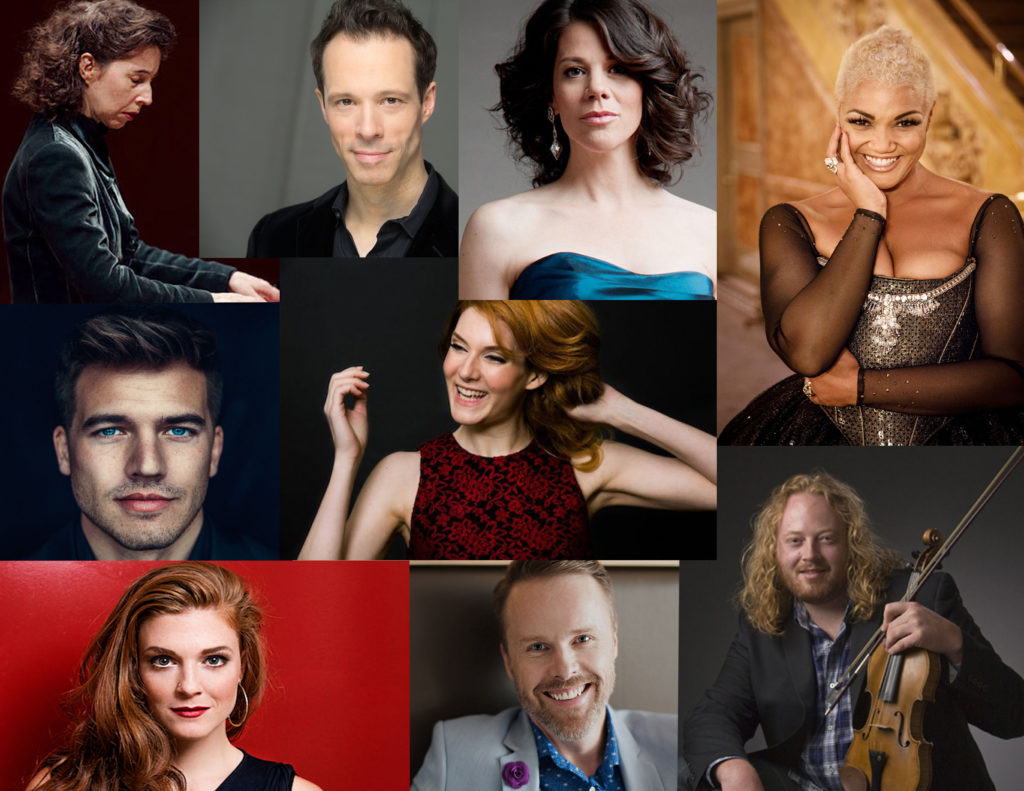A Telephone Conversation with Marshall Pynkoski
First and most important question, Marshall. How are you and Jeannette dealing with these terribly troubling times? What does a typical day, if there is such a thing for any of us anymore, look like for the two of you?
We’ve worked out a day that’s very predictable, very normal for lack of a better word. We have an enormous amount of work that we have to get through so we’re dealing with that as though we’re in the office even though we’re not there. My day starts very, very early in the morning as it has always done. 4:30 or 5:00 wake-up time. Every day a staff meeting happens at 9:45 that usually lasts half an hour to 45 minutes. Everyone phones in or joins on their computer. I use a land line. It’s amazing, really, because although I’d much rather be reacting with people face to face, I find this incredibly efficient. In some ways even more efficient because there are virtually no distractions. The fact is, we all hang up and then we go and do what we said we were going to do that day. But talking about us here, we’ve never been in one place, Jeanette and I together, for this long, particularly in our home which is a real oasis. But I’m anxious to get back.
So Opera Atelier carries on in spite of the lock-down. The pandemic must have made a deep impact, though. What has been your experience to date as co-artistic director beyond the cancellation of your production of Handel’s Resurrection at Koerner Hall last month?
It’s made us think more creatively and come up with really interesting solutions. We’d never be doing the sort of thing we’re doing with our upcoming virtual showcase, Together/Apart, if it weren’t for the current situation. Suddenly we find ourselves in a position, for example, where Measha Brueggergosman is recording in Nova Scotia. Edwin Huizinga is accompanying her on a violin in a cabin in California. And Christopher Bagan is playing a piano in his Toronto townhouse. It’s thrilling! These are not things to replace the actual live experience but they lead to all kinds of discoveries that have a sense of adventure about them. Jeannette taught her first piece of ballet virtually. She went through the choreography in our living room. She sent the video to Juri Hiraoka, one of our principal dancers. So in Together/Apart, beautiful Juri, wearing her warm-up clothes, is going through the choreography on her patio in front of her garage. It opens up a whole new vista in terms of how can we rehearse in these immediate circumstances. The situation has forced us to explore.
Tell us what sort of decision-making process guided you and Jeannette when you sat down to program Together/Apart?
It began when we decided that we were going to phone every individual personally who donated back their tickets for Resurrection and thank them and that turned into some really great conversations. We’re hearing the same thing again and again. Some people who’ve attended Opera Atelier ever since we were at the Art Gallery of Ontario 35 years ago. Some people who are brand new. They feel there is a warmth and caring on stage and a sense of repertory company. So when talking with Chris Bagan, with David Fallis and also our videographer Marcel Canzona and with Gerard Gauci, everyone connected with the project, we just felt that we wanted to provide an experience that was authentic. We wanted people to see the artists as people. Our audience will come away knowing more about the artists — the hardest thing was choosing who was to appear — more about their relationships to each other. They’ll even find out some things about how artists have fit into our company over time. Laird Mackintosh, who began his career with the National Ballet of Canada, then went on to sing Raoul in Phantom, then he came to us — Laird is one of those people who in the most wonderful way is always dissatisfied — he came to us years ago and said, “I want to sing opera!” And he auditioned for us and it was so charming, so beautiful, we put him into our production of Bourgeois Gentilhomme. He ended up being with us three or four years. So we got in touch with him and said, “Laird, you have to do the thing you’re most famous for. You sing Phantom on Broadway. You have to sing Music of the Night.” And there he is, standing in a corner of his living room, singing his heart out! These were all things we discussed. How do we create a genuine experience, a quality experience that really shows off people well? Mireille Lebel who appeared in our production of Return of Ulysses said to us, “I’m in Vancouver and I’ve got this fabulous beach. It’s the perfect place for someone to film me as Penelope.” It all just grew on its own, about an hour in length. We’ve even got a message from Mayor Tory.
Does he sing? Never mind. The proliferation of digital performances and webstreams these days feels like more than a passing fad. Do you think the technology will continue to occupy a meaningful place in opera once normalcy returns to live theatre whenever that may be? Is this the 21st century equivalent of the 18th or 19th century salon?
I think that’s a very interesting allusion. I think many of these endeavours are best when there is a sense of intimacy, a welcoming of people in. I think it has a great role to play in that respect. Every time there’s new technology, it adds to the pool of options for audiences. I don’t think, however, anything eradicates or replaces the excitement of a live performance. But I don’t think it’s a threatening thing. I see it as an exciting tool to attract people and maybe open imaginations to opera. Maybe it’s a whole other audience. We’re going to continue to explore this, particularly from the point of view of education. Whenever we do an opera, for an entire week leading up to that, we have kids from the GTA come in and spend the entire day with us in the studio. They have a dance class with Jeannette. They do fencing with Jennifer Parr. One of our singers comes in and sings for them and gets them singing. Gerard Gauci works through set design and talks about that. I give them an overview. There are hundreds of kids who want to attend who we just can’t reach. We don’t have the time. We don’t have the number of resource people because it’s all entirely free. So we’re looking at the ability to create opera experiences digitally and produce packages for anyone who lives too far away or who comes to us too late and our Making of An Opera is full. If Jeannette is able to teach a piece of choreography to Juri from our living room then Jeannette should be able to teach simple dance steps to a group of high school students in the Maritimes. Why not?
Why not, indeed? What will be the process of bringing opera fully back to speed in the post COVID-19 era — large scale productions, mass audiences? What will the interim period look like when public health regulations governing social distancing on stage and in theatres are likely still in force to a greater or lesser degree? Can you speculate?
I think initially we have to be clever in terms of how we choose repertoire to see what things lend themselves to that reality best. Our upcoming season, our 35th Anniversary, we’re looking at Magic Flute, which was a real turning point for the company, and the first opera we ever produced, Dido and Aeneas. Now it may be that we flip the order. It would be much simpler — and I’m just thinking out loud, I’m not saying we are — for us to create a performance environment that meets whatever those stipulations are going to be with Dido than Flute. But something even more basic than that. I love large numbers. It’s wonderful to have the support of those numbers on stage. But at the same time I really do believe that there’s a tremendous power that comes from proportion and how you work with that. You can have a fantastic impact with 20 people on stage but I think if you have artists who are truly focused on the scene, focused on the storytelling, focused on the narrative, and putting in the amount of rehearsal time necessary to achieve that, I think that we can continue to create productions that still deliver the experience that our audience longs for.
Are you thinking chamber works? Or perhaps looking at the indie opera model — performing in smaller, more intimate venues with reduced sized audiences?
That’s where we started. It’s not something I’m necessarily searching for. We have commitments right now that we want to honour. Moving forward, those productions we want to get to are going to require numbers. But the thing about Opera Atelier, and what has always been great and which is why we have been able to expand the way we have and tour the way we have is that we are still a small organization. And because we are small, we can move quickly. So if we find ourselves doing a production in the Art Gallery of Ontario or that is outside — we cut our teeth on that. It’s something we could return to very easily. And very happily. I don’t want to think of this as a problem. This is a phenomenon that we are living with. How do we respond to it as artists? Artists, should be responding with hope. They should be responding with authenticity. They should be responding with something that gives people a sense that there’s something bigger that takes them out of themselves. That’s why we have opera.
* * *
Together/Apart, a virtual showcase, debuts on operaatelier.com Wednesday, May 20, 8:00 PM EST. Featured singers: Douglas Williams, Mireille Lebel, Wallis Giunta, Meghan Lindsay, Allyson McHardy, Melody Louledjian, Laird Mackintosh, Measha Bruggergosman, Colin Ainsworth, Karine White. Dancers: Xi Yi, Juri Hiraoka. Musical guests: Angela Hewitt piano, Edwin Huizinga violin.


